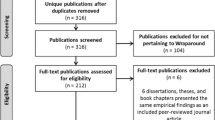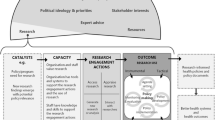Abstract
The wraparound process has increasingly been used as a mechanism to plan and coordinate services for children with behavioral health needs and their families. This has led to growing interest in assessing wraparound implementation against standards for quality. However, there has been little consideration of how best to establish such benchmarks or guidelines. Using both a norm-referenced and criterion-referenced approach, this study established preliminary criteria for assessing the adequacy of wraparound implementation using the Wraparound Fidelity Index, version 3, a multi-informant interview that assesses conformance to wraparound principles. The evaluation system was then applied to ten wraparound programs and 11 different study samples assessed via the Wraparound Fidelity Index version 3 in research studies. The system was constructed to discriminate different wraparound conditions assessed in research studies while still being attainable by the ten established wraparound programs. Implications for evaluating wraparound programs and for setting fidelity benchmarks in behavioral health services research are discussed.
Similar content being viewed by others
References
Salyers MP, Bond GR, Teague GB, et al. Is it ACT yet? Real-world examples of evaluating the degree of implementation for assertive community treatment. Journal of Behavioral Health Services & Research. 2003;13:304–320.
Bruns EJ, Burchard JD, Suter JC, et al. Assessing fidelity to a community-based treatment for youth: the Wraparound Fidelity Index. Journal of Emotional and Behavioral Disorders. 2004;12:79–89.
Test MA, Stein LI. Community treatment of the chronic patient: Research overview. Schizophrenia Bulletin. 1980;4:350–364.
Burchard JD, Bruns EJ, Burchard SN. The wraparound process. In: Burns B, Hoagwood K, English M, eds. Community-Based Interventions for Youth. New York, NY: Oxford University Press; 2002:69–90.
Farmer EMZ, Dorsey S, Mustillo SA. Intensive home and community interventions. Child and Adolescent Psychiatric Clinics of North America. 2004;13:857–884.
Carney MM, Buttell F. Reducing juvenile recidivism: evaluating the wraparound services model. Research on Social Work Practice. 2004;13:551–568.
Pullman MD, Kerbs J, Koroloff N, et al. Juvenile offenders with mental health needs: reducing recidivism using wraparound. Crime and Delinquency. 2006;52:375–397.
Kamradt B. Wraparound Milwaukee: aiding youth with mental health needs. Juvenile Justice. 2000;7:14–23.
Anderson JA, Wright ER, Kooreman HE, et al. The Dawn project: a model for responding to the needs of young people with emotional and behavioral disabilities and their families. Community Mental Health Journal. 2003;39:63–74.
Bruns EJ, Rast J, Walker JW, et al. Applying evaluation data and the wraparound process to achieve systems change for children and families. American Journal of Community Psychology. 2006;38:201–212.
Faw L. The state wraparound survey. In: Burns BJ, Goldman SK, eds. Systems of Care: Promising Practices in Children’s Mental Health, 1998 series. Vol. IV: Promising Practices in Wraparound for Children with Severe Emotional Disorders and Their Families. Washington, DC: Center for Effective Collaboration and Practice, American Institutes for Research; 1999:27–32.
Weisz JR, Sandler IN, Durlak JA, et al. A proposal to unite two different worlds of children’s mental health. American Psychologist. 2006;61:644–645.
US Public Health Service. Mental Health. A Report of the Surgeon General. US Department of Health and Human Services Administration, Center for Mental Health Services. Rockville, MD: National Institute of Mental Health; 1999.
US Public Health Service. Youth Violence: A report of the Surgeon General. US Department of Health and Human Services Administration, Center for Mental Health Services. Rockville, MD: National Institute of Mental Health; 2001.
US Department of Health and Human Services. Cooperative Agreements for the Comprehensive Community Mental Health Services for Children and Their Families Program (SM-05–010); 2005. Available at http://www.systemsofcare.samhsa.gov. Accessed September 2, 2005.
Friedman R, Drews D. Evidence based practices, systems of care, and individualized care. Tampa, FL: University of South Florida, Louis de la Parte Florida Mental Health Institute, Department of Child and Family Studies. The Research and Training Center for children’s Mental Health; 2005.
Tolan P, Dodge K. Children’s mental health as a primary care and concern: a system for comprehensive support and services. American Psychologist. 2005;60:601–614.
Bruns EJ, Suter JC, Leverentz-Brady KM. Relations between program and system variables and fidelity to the wraparound process for children and families. Psychiatric Services. 2006;57:1586–1593.
Bruns EJ, Burchard JD, Suter JC, et al. Adherence to wraparound principles and association with outcomes. Journal of Child and Family Studies. 2005;14:521–534.
Ferguson C. California’s title IV-E child welfare waiver demonstration project evaluation: an analysis of wraparound in Alameda County. In: Newman C, Liberton C, Kutash K, et al, eds. The 17th Annual Research Conference Proceedings: A System of Care for Children’s Mental Health. Tampa, FL: University of South Florida, Florida Mental Health Institute Research and training Center for Children’s Mental Health; 2004:149–153.
Hagen M, Noble K, Schick C, et al. The relationship between fidelity to wraparound and positive behavior outcomes. In: Newman C, Liberton CJ, Kutash K, et al, eds. The 16th Annual Research Conference Proceedings, A System of Care for Children’s Mental Health: Expanding the Research Base. Tampa, FL: University of South Florida, The Louis de la Parte Florida Mental Health Institute, Research and Training Center for Children’s Mental Health; 2003:293–296.
Suter JC, Burchard JD, Bruns EJ, et al. User’s Manual to the Wraparound Fidelity Index 3.0. Burlington, VT: University of Vermont Department of Psychology; 2005.
Sather A, Bruns EJ, Stambaugh LF, et al. The state wraparound survey. Presented at the Building on Family Strengths Conference. Portland, OR: Research and Services in Support of Children and their Families; 2007.
Peterson CR, Gruner L, Earnest L, et al. Comparing functional outcomes of wraparound and traditional mental health and child welfare services. In: Newman C, Liberton CJ, Kutash K, et al, eds. The 16th Annual Research Conference Proceedings, A System of Care for Children’s Mental Health: Expanding the Research Base. Tampa: FL: University of South Florida, The Louis de la Parte Florida Mental Health Institute, Research and Training Center for Children’s Mental Health; 2004:307–311.
Bruns EJ, Suter JD, Leverentz-Brady K. A national portrait of wraparound implementation. In: Newman C, Liberton C, Kutash K, et al, eds. The 16th Annual Research Conference Proceedings: A System of Care for Children’s Mental Health. Tampa, FL: University of South Florida, Florida Mental Health Institute Research and training Center for Children’s Mental Health; 2004:281–286.
Hodges K. Child and Adolescent Functional Assessment Scale. Ypsilanti, MI: Eastern Michigan University, Department of Psychology; 1997.
Rast J, Peterson CR, Earnest L, et al. Service process as a determinant of treatment effect—the importance of fidelity. In: Newman C, Liberton CJ, Kutash K, et al, eds. The 16th Annual Research Conference Proceedings, a System of Care for Children’s Mental Health: Expanding the Research Base. Tampa, FL: University of South Florida, The Louis de la Parte Florida Mental Health Institute, Research and Training Center for Children’s Mental Health; 2004:311–315.
Rast J, VanDenBerg J. Certification of facilitators as a method for increasing wraparound fidelity. In: Newman C, Liberton CJ, Kutash K, et al, eds. The 16th Annual Research Conference Proceedings, a System of Care for Children’s Mental Health: Expanding the Research Base. Tampa, FL: University of South Florida, The Louis de la Parte Florida Mental Health Institute, Research and Training Center for Children’s Mental Health; 2004:315–320.
Walker JS, Bruns EJ. The wraparound process: Individualized care planning and management for children and families. In: Rosenberg S, Rosenberg J, eds. Community Mental Health Reader: Current Perspectives. New York: Routledge; 2006:44–54.
Walker JS, Bruns EJ. Surveying experts to define the wraparound process for children and families: An example of practice-based evidence. Psychiatric Services. 2006;57:1579–1585.
Stambaugh LF, Mustillo SA, Burns BJ, et al. Outcomes from wraparound and multisystemic therapy in a Center for Mental Health Services system-of-care demonstration site. Journal of Emotional and Behavioral Disorders. 2007;17:143–155.
Henggeler SW, Schoenwald S, Rowland MD, et al. Serious Emotional Disturbance In Children and Adolescents: Multisystemic Therapy. New York: Guilford; 2002.
Achenbach TM. Manual for the Child Behavior Checklist/4–18 & 1991 Profile. Burlington: University of Vermont Department of Psychiatry; 1991.
Stroul B, Friedman R. The system of care concept and philosophy. In: Stroul B, ed. Children’s Mental Health: Creating Systems of Care in a Changing Society. Baltimore, MD: Paul H. Brookes; 1996.
Fixen DL, Naoom SF, Blasé KA, et al. Implementation research: A synthesis of the literature. FMHI pub. no. #231. Tampa, FL: University of South Florida, Louis de la Parte Florida Mental Health Institute, The National Implementation Research Network; 2005.
Rosenheck RA. Organizational process: A missing link between research and practice. Psychiatric Services. 2001;52:1607–1612.
Acknowledgment
This research received support from several sources, including the Center for Mental Health Services, Substance Abuse and Mental Health Services Administration; the Child, Adolescent, and Family Unit of the Vermont Department of Developmental and Mental Health Services; and ORC Macro, Inc. We would like to thank April Sather, MPH, for her assistance in manuscript preparation.
Author information
Authors and Affiliations
Corresponding author
Rights and permissions
About this article
Cite this article
Bruns, E.J., Suter, J.C. & Leverentz-Brady, K. Is It Wraparound Yet? Setting Quality Standards for Implementation of the Wraparound Process. J Behav Health Serv Res 35, 240–252 (2008). https://doi.org/10.1007/s11414-008-9109-3
Received:
Accepted:
Published:
Issue Date:
DOI: https://doi.org/10.1007/s11414-008-9109-3




